Class 7 Maths Chapter 1 Integers NCERT Solutions
Integers Exercise 1.1
Ex 1.1 Class 7 Maths Question 1.
Following number line shows the temperature in degree Celsius (°C) at different places on a particular day.
(a) Observe this number line and write the temperature of the places marked on it.
(b) What is the temperature difference between the hottest and the coldest places among the above?
(c) What is the temperature difference between Lahulspriti and Srinagar?
(d) Can we say temperature of Srinagar and Shimla taken together is less than the temperature at Shimla? Is it also less than the temperature at Srinagar?
Solution:
(a) From the given number line, we observe the following temperatures.
| Cities | Temperature |
| Lahulspriti | -8°C |
| Srinagar | -2°C |
| Shimla | 5°C |
| Ooty | 14°C |
| Bengaluru | 22°C |
(b) The temperature of the hottest place = 22°C
The temperature of the coldest place = -8°C
Difference = 22°C – (-8°C)
= 22°C + 8°C = 30°C
(c) Temperature of Lahulspriti = -8°C
Temperature of Srinagar = -2°C
∴ Difference = -2°C – (-8°C)
= -2°C + 8°C = 6°C
(d) Temperature of Srinagar = -2°C
Temperature of Shimla = 5°C
∴ Temperature of the above cities taken together
= -2°C + 5°C = 3°C
Temperature of Shimla = 5°C
Hence, the temperature of Srinagar and Shimla taken together is less than that of Shimla by 2°C.
i.e., (5°C – 3°C) = 2°C
Ex 1.1 Class 7 Maths Question 2.
In a quiz, positive marks are given for correct answers and negative marks are given for incorrect answers. If Jack’s scores in five successive rounds were 25, -5, -10, 15 and 10, what was his total at the end?
Solution:
Given scores are 25, -5, -10, 15, 10
Marks given for correct answers
= 25 + 15 + 10 = 50
Marks given for incorrect answers
= (-5) + (-10) = -15
∴ Total marks given at the end
= 50 + (-15) = 50 – 15 = 35
Ex 1.1 Class 7 Maths Question 3.
At Srinagar temperature was -5°C on Monday and then it dropped by 2°C on Tuesday. What was the temperature of Srinagar on Tuesday? On Wednesday, it rose by 4°C. What was the temperature on this day?
Solution:
Initial temperature of Srinagar on Monday = -5°C
Temperature on Tuesday = -5°C – 2°C = -7°C
Temperature was increased by 4°C on Wednesday.
∴ Temperature on Wednesday
= -7°C + 4°C = -3°C
Hence, the required temperature on Tuesday = -7°C
and the temperature on Wednesday = -3°C
Ex 1.1 Class 7 Maths Question 4.
A plane is flying at the height of 5000 m above the sea level. At a particular point, it is exactly above a submarine flowing 1200 m below the sea level. What is the vertical distance between them?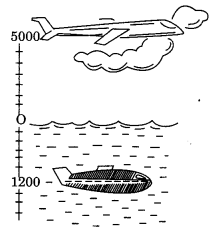
Solution:
Height of the flying plane = 5000 m
Depth of the submarine = -1200 m
∴ Distance between them
= + 5000 m – (-1200 m)
= 5000 m + 1200 m = 6200 m
Hence, the vertical distance = 6200 m
Ex 1.1 Class 7 Maths Question 5.
Mohan deposits ₹ 2,000 in a bank account and withdraws ₹ 1,642 from it, the next day. If withdrawal of amount from the account is represented by a negative integer, then how will you represent the amount deposited? Find the balance in Mohan’s account after the withdrawal.
Solution:
The deposited amount will be represented by a positive integer i.e., ₹ 2000.
Amount withdrawn = ₹ 1,642
∴ Balance in the account
= ₹ 2,000 – ₹ 1,642 = ₹ 358
Hence, the balance in Mohan’s account after the withdrawal
= ₹ 358
Ex 1.1 Class 7 Maths Question 6.
Rita goes 20 km towards east from a point A to the point B. From B, she moves 30 km towards west along the same road. If the distance towards east is represented by a positive integer, then how will you represent her final position from A?![]()
Solution:
Distances travelled towards east from point A will be represented by positive integer i.e. +20 km.
Distance travelled towards the west from point B will be represented by negative integer, i.e., —30 km.
Final position of Rita from A
= 20 km – 30 km = – 10 km
Hence, the required position of Rita will be presented by a negative number, i.e., -10.
Ex 1.1 Class 7 Maths Question 7.
In a magic square each row, column and the diagonal have the same sum. Check which of the following is a magic square?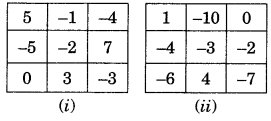
Solution:
(i) Row one R1 = 5 + (-1) + (—4)
=5 – 1 – 4 = 5 – 5 = 0
Row two R2 = (-5) + (-2) + 7
= -5 – 2 + 7 = -7 + 7 = 0
Row three R3 = 0 + 3 + (-3)
= 0 + 3- 3 = 0
Column one C1t = 5 + (-5) + 0
= 5 – 5 + 0 = 0
Column two C2 = (-1) + (-2) + (3)
=-1 – 2 + 3 = -3 + 3 = 0
Column three C3 = (-4) + 7 + (-3)
= -4 + 7 – 3 = 7 – 7 = 0
Diagonal d12 = 5 + (-2) + (-3)
= 5 – 2- 3 = 5 – 5 = 0
Diagonal d2 = (-4) + (-2) + 0
= -4 – 2 + 0 = -6 + 0 = -6
Here, the sum of the integers of diagonal d2 is different from the others.
Hence, it is not a magic square.
(ii) Row one R1 = 1 + (-10) + 0
= 1 – 10 + 0 = -9
Row two R2 = (-4) + (-3) + (-2)
= -4 – 3 – 2 = -9
Row three R3 = (-6) + (4) + (-7)
= -6 + 4 – 7 = -9
Column one C3 = 1 + (-4) + (-6)
= 1 – 4 – 6 = -9
Column two C2 = (-10) + (-3) + 4
= -10 – 3 + 4 = -9
Column three C3 = 0 + (-2) + (-7)
= 0 – 2 -7 = -9
Diagonal d1 = 1 + (-3) + (-7)
= 1 – 3 – 7 = 1 – 10 = -9
Diagonal d2 = 0 + (-3) + (-6)
= 0 – 3- 6 = -9
Here, sum of the integers column wise, row wise and diagonally is same i.e. -9.
Hence, (ii) is a magic square.
Ex 1.1 Class 7 Maths Question 8.
Verify a – (-b) = a + b for the following values of a and 6.
(i) a = 21, b = 18
(ii) a = 118, b = 125
(iii) a = 75, b = 84
(iv) a= 28, 6 = 11
Solution:
(i) a – (-b) = a + b
LHS = 21 – (-18) = 21 + 18 = 39
RHS = 21 + 18 = 39
LHS = RHS Hence, verified.
(ii) a – (-b) = a + b
LHS = 118 – (-125) = 118 + 125 = 243
RHS = 118 + 125 = 243
LHS = RHS Hence, verified.
(iii) a – (-b) = a + b
LHS = 75 – (-84) = 75 + 84 = 159
RHS = 75 + 84 = 159
LHS = RHS Hence, verified.
(iv) a – (-b) = a + b
LHS = 28 – (-11) = 28 + 11 = 39
RHS = 28 + 11 = 28 + 11 = 39
LHS = RHS Hence, verified.
Ex 1.1 Class 7 Maths Question 9.
Use the sign of >, < or = in the box to make the statements true.
(a) (-8) +(-4) □(-8)-(-4)
(b) (-3) + 7 – (19) □ 15 – 8 + (-9)
(c) 23 – 41 + 11 □ 23 – 41 – 11
(d) 39 + (-24) – (15) □ 36 + (-52) – (-36)
(e) -231 + 79 + 51 □ -399 + 159 + 81
Solution:
(a) (-8) + (-4) □ (-8) – (-4)
LHS = (-8) + (-4) = -8 – 4 = – 12
RHS = (-8) – (-4) = -8 + 4 = -4
Here – 12 < -4
Hence, (-8) + (-4) [<] (-8) – (-4)
(b) (-3) + 7 – (19) □ 15 – 8 + (-9)
LHS = (-3) + 7 – (19) =-3 + 7-19
= -3 – 19 + 7
= -22 + 1 = -15
RHS = 15 – 8 + (-9)
= 15-8-9
= 15 – 17 = -2
Here -15 < -2
Hence, (-3) + 7 – (19) [<] 15 – 8 + (-9)
(c) 23 – 41 + 11 □ 23 – 41 – 11
LHS = 23 – 41 + 11 = 23 + 11 – 41 = 34 – 41 = -7
RHS = 23 – 41 – 11 = 23 – 52 = -29 Here, -7 > -29
Hence, 23 – 41 + 11 [>] 23 – 41 – 11
(d) 39 + (-24) – (15) □ 36 + (-52) – (-36)
LHS = 39 + (-24) – (15)
= 39 – 24 – 15
= 39 – 39 = 0
RHS = 36 + (-52) – (-36) = 36 – 52 + 36
= 36 + 36 – 52
= 72 – 52 = 20
Here 0 < 20
Hence, 39 + (-24) – (15) [<] 36 + (-52) – (-36)
(e) -231 + 79 + 51 □ -399 + 159 + 81
LHS = -231 + 79 + 51 = -231 + 130 = -101
RHS = -399 + 159 + 81 = -399 + 240 = -159
Here, -101 > -159
Hence, -231 + 79 + 51 [>] -399 + 159 + 81
Ex 1.1 Class 7 Maths Question 10.
A water tank has steps inside it. A monkey is sitting on the topmost step (i.e., the first step). The water level is at the ninth step.
(i) He jumps 3 steps down and then jumps back 2 steps up. In how many jumps will he reach the water level?
(ii) After drinking water, he wants to go back. For this, he jumps 4 steps up and then jumps back 2 steps down in every move. In how many jumps will he reach back the top step?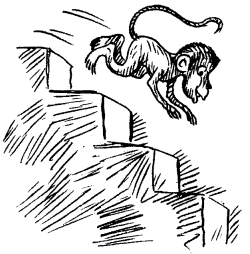
(iii) If the number of steps moved down is represented by negative integers and the number of steps moved up by positive integers, represent his move in part (t) and (ii) by completing the following:
(a) – 3 + 2 – … = -8
(b) 4 – 2 + … = 8. In (a) the sum (-8) represents going down by eight steps. So, what will the sum 8 in
(b) represent?
Solution:
(i) The position of monkey after the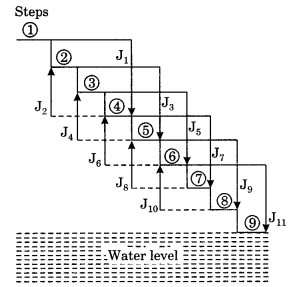
1st jump J1 is at 4th step ↓
2nd jump J2 is at 2nd step ↑
3rd jump J3 is at 5th step ↓
4th jump J4 is at 3rd step ↑
5th jump J5 is at 6th step ↓
6th jump J6 is at 4th step ↑
7th jump J7 is at 7th step ↓
8th jump J8 is at 5th step ↑
9th jump J9 is at 8th step ↓
10th jump J10 is at 6th step ↑
11th jump J11 is at9th step ↓ (Water level)
Hence the required number of jumps = 11.
(ii) Monkey’s position after the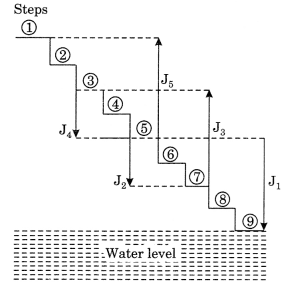
1st jump J1 is at 5th step ↑
2nd jump J2 is at 7th step ↓
3rd jump J3 is at 3rd step ↑
4th jump J4 is at 5th step ↓
5th jump J5 is at 1st step ↑
Hence, the required number of jumps = 5.
(iii) According to the given conditions we have the following tables
| Jumps | J1 | J2 | J3 | J4 | J5 | J6 | J7 | J8 | J9 | J10 | J11 |
| Number of steps | -3 | +2 | -3 | +2 | -3 | +2 | -3 | +2 | -3 | +2 | -3 |
Therefore (a) Total number of steps
=-3 + 2 – 3 + 2 – 3 + 2 – 3 + 2 – 3 + 2 – 3
= -8 which represents the monkey goes down by 8 steps.
In case (ii), we get
| Jumps | J1 | J2 | J3 | J4 | J5 |
| Number of steps | + 4 | -2 | +4 | -2 | +4 |
Therefore (b) Total number of steps.
= +4 – 2 + 4 – 2 + 4 = 8
Here, the monkey is going up by 8 steps.
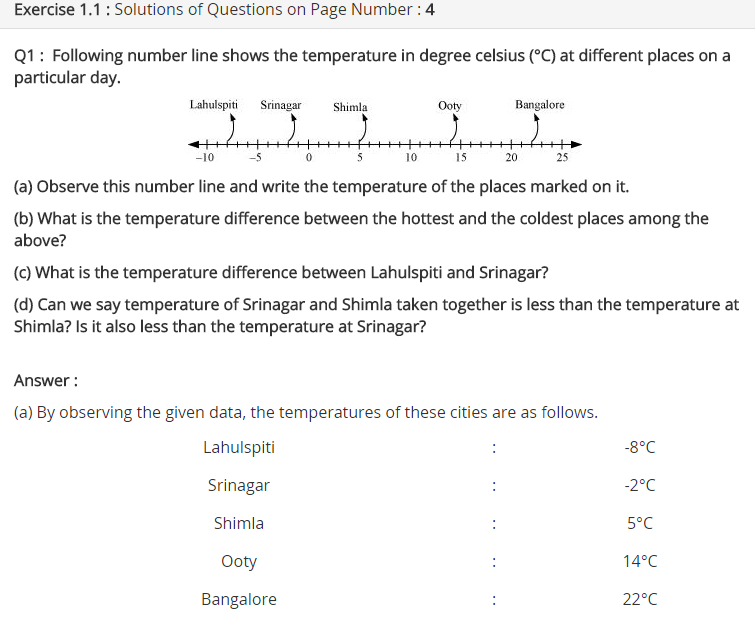
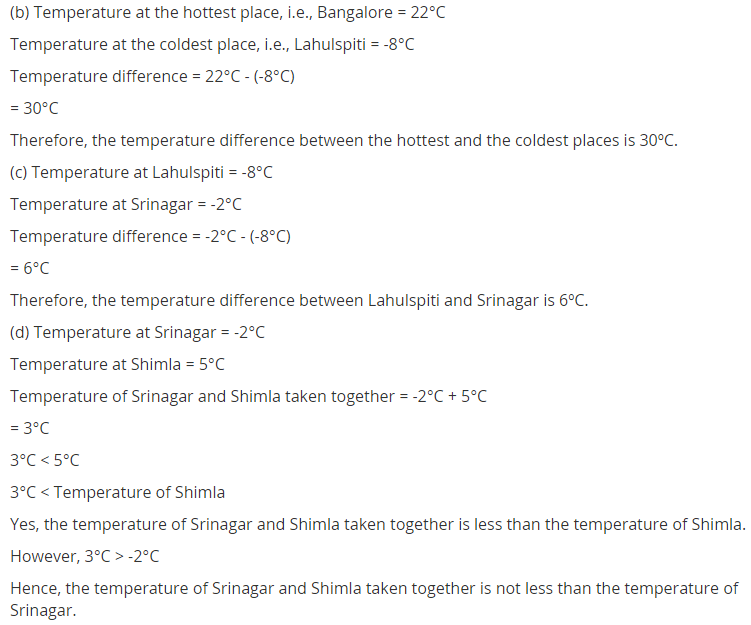

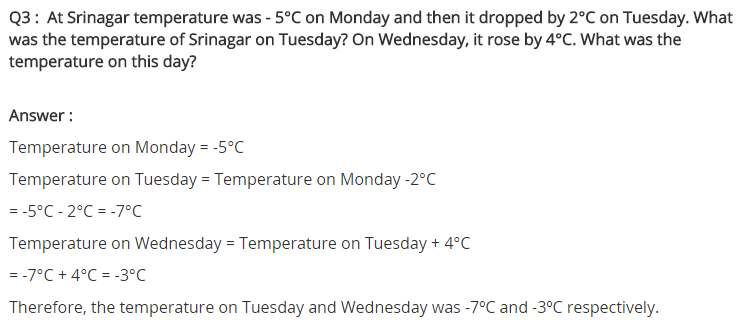
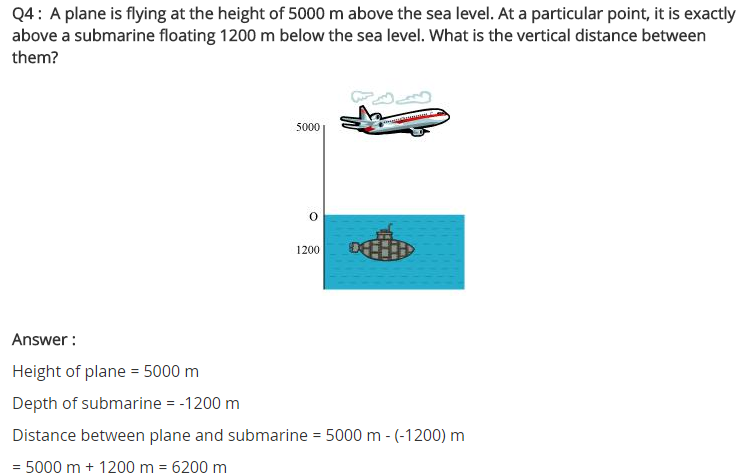
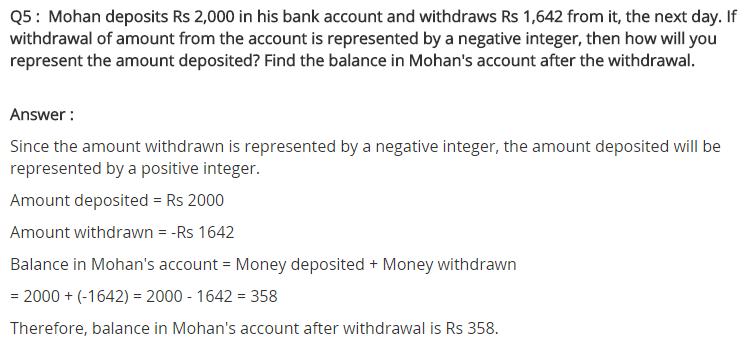
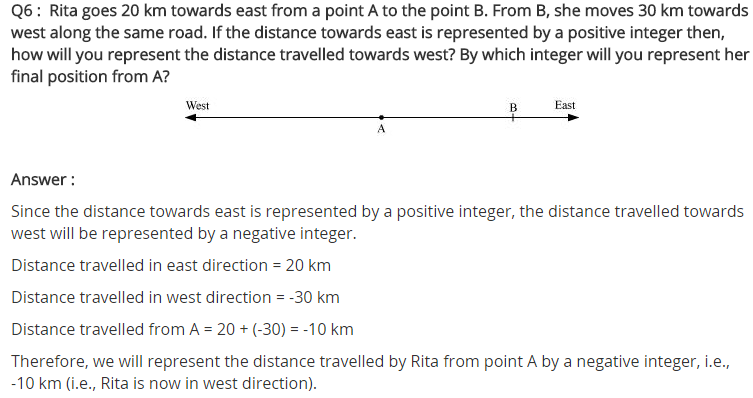
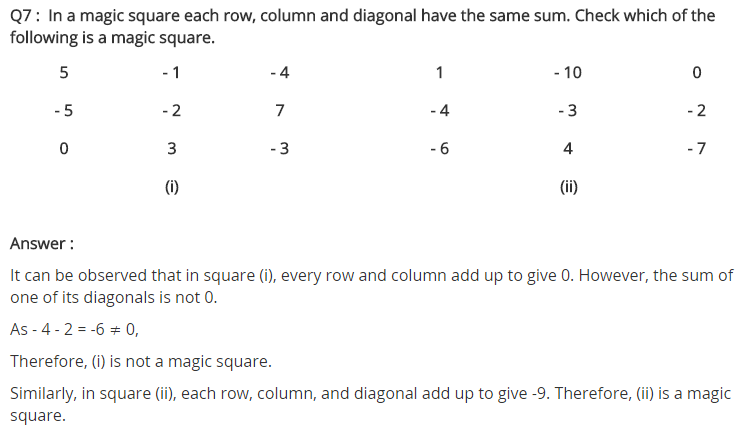
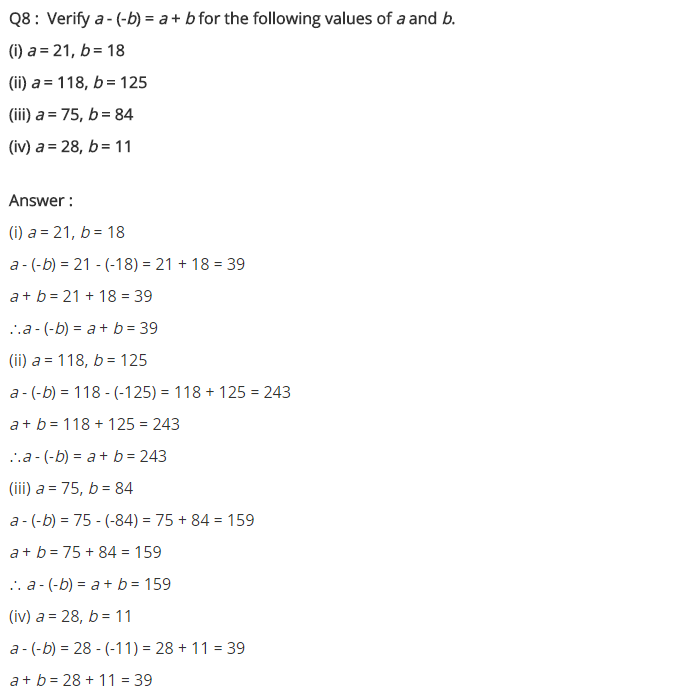
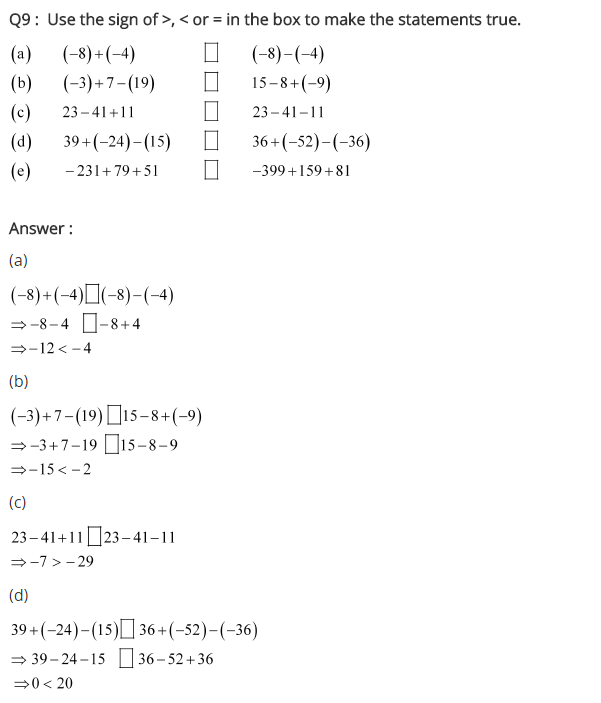

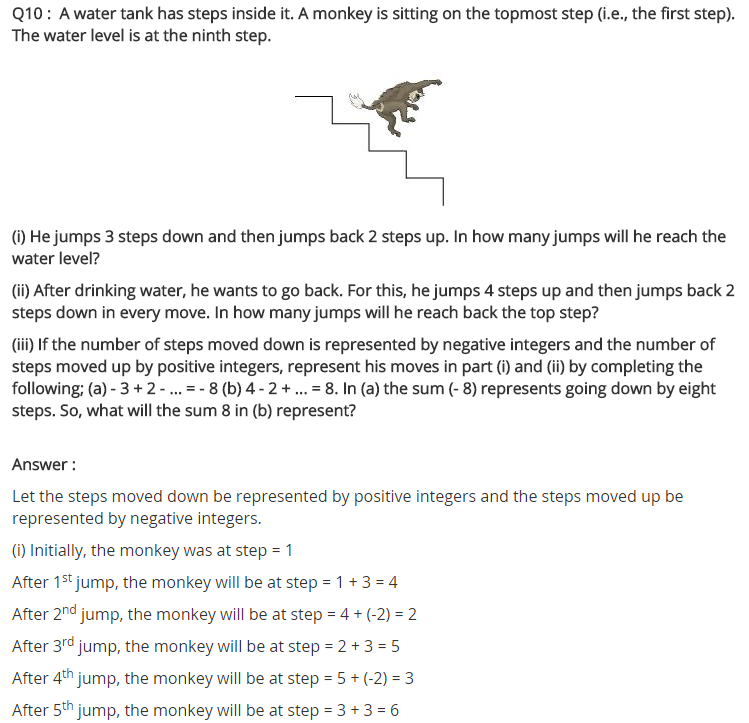
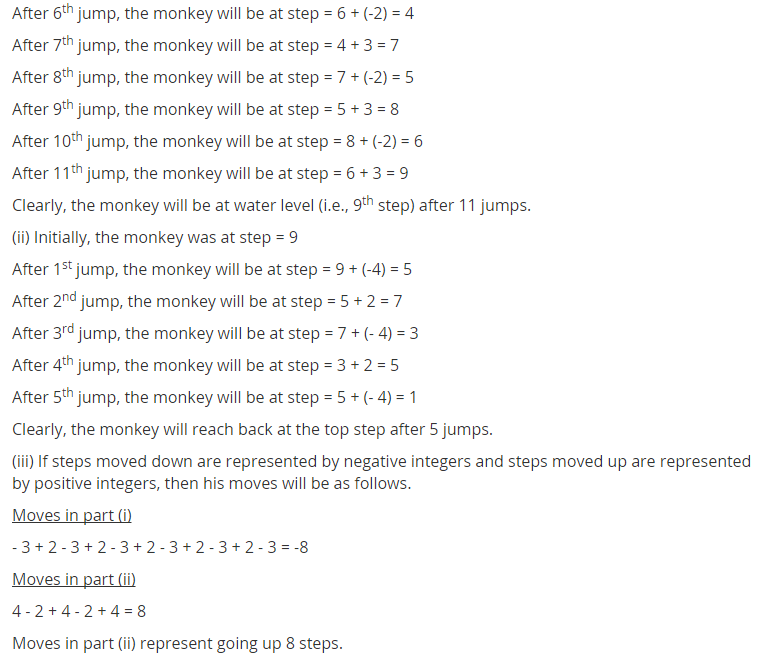
NCERT Solutions for Class 7 Maths Chapter 1 Integers Exercise 1.2
Ex 1.2 Class 7 Maths Question 1.
Write down a pair of integers whose:
(a) sum is -7
(b) difference is -10
(c) sum is 0.
Solution:
(a) Let us take a pair of integers -3 and -4.
∴ (-3) + (-4) = -3 – 4 = -7
(b) Let us take a pair of integers -12 and -2
∴ (-12) – (-2) = -12 + 2 = -10
(c) Let us take a pair of integers -3 and 3
∴ (-3) + (3) = -3 + 3 = 0
Ex 1.2 Class 7 Maths Question 2.
(a) Write a pair of negative integers whose difference gives 8.
(b) Write a negative integer and positive integer whose sum is -5.
(c) Write a negative integer and a positive integer whose difference is -3.
Solution:
(a) Let us have -2 and -10
∴ Difference = (-2) – (-10) = -2 + 10 = 8
(b) Let us have -7 and 2
∴ (-7) + (2) = -7 + 2 = -5
(c) Let us have -2 and 1
∴ (-2) – (1) = – 2 – 1 = -3
Ex 1.2 Class 7 Maths Question 3.
In a quiz, team A scored -40, 10, 0 and team B scored 10, 0, -40 in three successive rounds. Which team scored more? Can you say that we can add integers in any order?
table
Solution:
Total score of team
A = (-40) + (10) + (0) – -40 + 10 + 0 = -30
Total score of team
B = 10 + 0 + (-40) = 10 + 0 – 40 – -30
∴ The scores of both the teams are same i.e. -30.
Yes, we can add the integers in any order.
Ex 1.2 Class 7 Maths Question 4.
Fill in the blanks to make the following statements true:
(i) (-5) + (-8) = (-8) + (…)
(ii) -53 + … = -53
(iii) 17 + … = 0
(iv) [13 + (-12)] + (…) = 13 + [(-12) + (-7)]
(v) (-4) + [15 + (-3)] = [-4 + 15] + …
Solution:
(i) -5 + (-8) – (-8) + (-5) [Commutative law of additions]
(ii) -53 + 0 = -53 [Additive Identity]
[Adding 0 to any integer, it gives the same value]
(iii) 17 + (-17) = 0 [Additive inverse]
(iv) [13 + (-12)] + (-7) – 13 + [(-12) + (-7)] [Associative law of addition]
(v) (-4) + [15 + (-3)] – [-4 + 15] + (-3) [Associative law of addition]
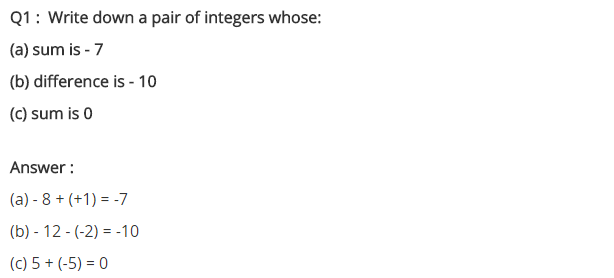
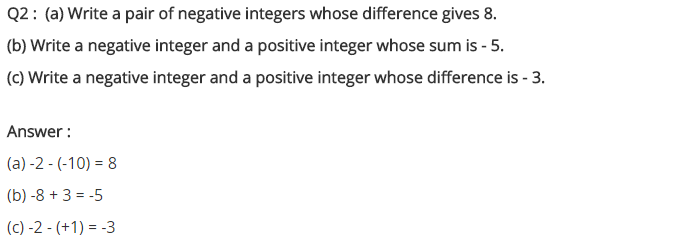
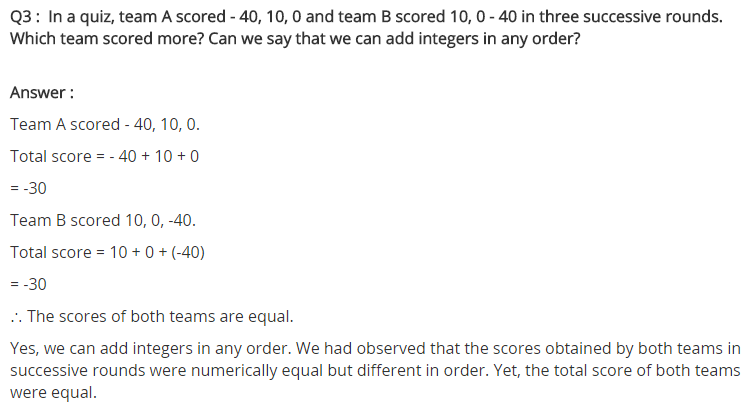
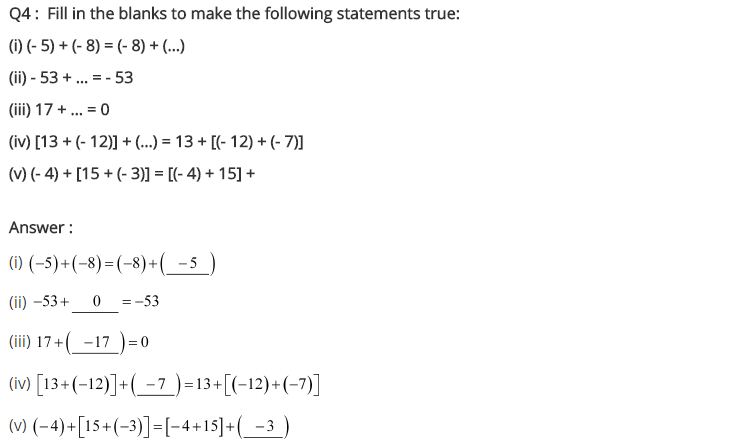
NCERT Solutions for Class 7 Maths Chapter 1 Integers Exercise 1.3
Ex 1.3 Class 7 Maths Question 1.
Find each of the following products:
(a) 3 × (-1)
(b) (-1) × 225
(c) (-21) × (-30)
(d) (-316) × (-1)
(e) (-15) × 0 × (-18)
(f) (-12) × (-11) × (10)
(g) 9 × (-3) × (-6)
(h) (-18) × (-5) × (-4)
(i) (-1) ×(-2) × (-3) × 4
(j) (-3) × (-6) × (-2) × (-1)
Solution:
(a) 3 × (-1) = -3 × 1 = -3
(b) (-1) × 225 = -1 × 225 = -225
(c) (-21) × (-30) = (-) × (-) × 21 × 30 = 630
(d) (-316) × (-1) = (-) × (-) × 316 × 1 = 316
(e) (-15) × 0 × (-18) = 0 [∵ a × 0 = a]
(f) (-12) × (-11) × (10)
= (-) × (-) × 12 × 11 × 10 = 1320
(g) 9 × (-3) × (-6) = (-3) × (-6) × 9
= (—) × (-) × 3 × 6 × 9 = 162
(h) (-18) × (-5) × (-4)
= (-) × (-) × (-) × 18 × 5 × 4 = -360
(i) (-1) × (-2) × (-3) × 4
= (-) × (-) × (-) × 1 × 2 × 3 × 4 = -24
(j) (-3) × (-6) × (-2) × (-1)
= (-) × (-) × (-) × (-) × 3 × 6 × 2 × 1 = 36
Ex 1.3 Class 7 Maths Question 2.
Verify the following:
(a) 18 × [7 + (-3)] = [18 × 7] + [18 × (-3)]
(b) (-21) × [(-4) + (-6)] = [(-21) × (-4)] + [(-21) × (-6)]
Solution:
(a) 18 × [7 + (-3)] = [18 × 7] + [18 × (-3)]
LHS = 18 × [7 + (-3)] = 18 × 4 = 72
RHS = [18 × 7] + [18 × (-3)] = 126 + (-54)
= 126 – 54 = 72
LHS = RHS
Hence, verified.
(b) (-21) × [(-4) + (-6)] = [(-21) × (-4)] + [(-21) × (-6)]
LHS = (-21) × [(-4) + (-6)]
= (-21) × (-10)
= (-) × (-) × 21 × 10 = 210
RHS = [(-21) × (-4)] + [(-21) × (-6)]
= (84) + (126) = 84 + 126 = 210
LHS = RHS
Hence, verified.
Ex 1.3 Class 7 Maths Question 3.
(i) For any integer a, what is (-1) × a equal to?
(ii) Determine the integer whose product with (-1) is 0.
(a) -22
(b) 37
(c) 0
Solution:
(i) (-1) × a = -a
(ii) (-1) × 0 = 0 [∵ a × 0 = 0]
Hence (c) 0 is the required integer.
Ex 1.3 Class 7 Maths Question 4.
Starting from (-1) × 5, write various products showing some pattern to show (-1) × (-1) = 1
Solution:
(-1) × 5 = -5
(-1) × 4 = -4 = (-5) + 1
(-1) × 3 = -3 = (-4) + 1
(-1) × 2 = -2 = (-3) + 1
(-1) × (1) = -1 = (-2) + 1
(-1) × 0 = 0 – (-1) + 1
(-1) × (-1) = 1 = 0+1
Ex 1.3 Class 7 Maths Question 5.
Find the product, using suitable properties:
(a) 26 × (-48) + (-48) × (-36)
(b) 8 × 53 × (-125)
(c) 15 × (-25) × (-4) × (-10)
(d) (-41) × 102
(e) 625 × (-35) + (-625) × 65
(f) 7 × (50 – 2)
(g) (-17) × (-29)
(h) (-57) × (-19) + 57
Solution:
(a) 26 × (-48) + (-48) × (-36)
= -48 × [26 + (-36)] = -48 × [26 – 36] = -48 × -10 = 480 [Distributive property of multiplication over
addition]
(b) 8 × 53 × (-125) = 53 × [8 × (-125)]
[Associative property of multiplication] = 53 × (-1000) = -53000
(c) 15 × (-25) × (-4) × (-10)
= [(-25) × (-4)] × [15 × (-10)]
[Regrouping the terms] = 100 × (-150) = -15000
(d) (-41) × 102 = (-41) × [100 + 2]
= (-41) × 100 + (-41) × 2
[Distributive property of multiplication over addition] = -4100 – 82 = -4182
(e) 625 × (-35) + (-625) × 65
= 625 × [(-35) + (-65)]
[Distributive property of multiplication over addition]
= 625 × (-100) = -62500
(f) 7 × (50 – 2) = 7 × 48 = 336 or
7 × (50 – 2) = 7 × 50 -7 × 2 = 350 – 14 = 336 [Distributive property of multiplication over addition]
(g) (-17) × (-29) = (-17) × [30 + (-1)]
= (-17) × 30 + (-17) × (-1)
= -510 + 17 = -493
[Distributive property of multiplication over addition]
(h) (-57) × (-19) + 57 = 57 × 19 + 57
= 57 × 19 + 57 × 1 [Y (-) × (-) = (+)] [Distributive property of multiplication over addition]
= 57 × (19 + 1) = 57 × 20 = 1140
Ex 1.3 Class 7 Maths Question 6.
A certain freezing process requires that room temperature be lowered from 40°C at the rate of 5°C every hour. What will be the room temperature 10 hours after the process begins?
Solution:
Temperature of the room in the beginning = 40°C
Temperature after 1 hour
= 40°C – 1 × 5°C = 40°C – 5°C – 35°C
Similarly, temperature of the room after 10 hours
= 40°C – 10 × 5°C = 40°C – 50°C = -10°C
Ex 1.3 Class 7 Maths Question 7.
In a class test containing 10 questions, 5 marks are awarded for every correct answer and (-2) marks are awarded for every incorrect answer and 0 for questions not attempted.
(i) Mohan gets four correct and si× incorrect answers. What is his score?
(ii) Reshma gets five correct answers and five incorrect answers, what is her score?
(iii) Heena gets two correct and five incorrect answers out of seven questions she attempts. What is her score?
Solution:
(i) Marks awarded to Mohan = 4 × 5
=20 for correct answers Marks awarded to Mohan = 6 × (-2)
= -12 for incorrect answers.
∴ Total marks obtained by Mohan
= 20 + (-12) = 20 – 12 = 8
(ii) Marks awarded to Reshma for correct answers
= 5 × 5 = 25
Marks awarded to Reshma for incorrect answers
= 5 × (-2) = -10
∴ Total marks obtained by Reshma
= 25 + (-10) = 25 – 10 = 15
(iii) Marks awarded to Heena for correct answers
= 2 × 5 = 10
Marks awarded to Heena for incorrect answers
= 5 × (-2) = -10
Number of question not attempted by Heena
= 10 – (2 + 5) = 10 – 7 = 3
Marks awarded to Heena for non-attempted questions
=3×0=0
∴ Total marks obtained by Heena
= 10 + (-10) + 0 = 10-10+ 0 = 0
Ex 1.3 Class 7 Maths Question 8.
A cement company earns a profit of ₹ 8 per bag of white cement sold and a loss of ₹ 5 per bag of grey cement sold.
(a) The company sells 3,000 bags of white cement and sold 5,000 bags of grey cement in a month. What is its profit or loss?
(b) What is the number of white cement bags it must sell to have neither profit nor loss, if the number of grey bags sold is 6,400 bags.
Solution:
(a) Profit on one white cement bag = ₹ 8
loss on one grey cement bag = ₹ – 5
Profit on 3,000 bags of white cement
= ₹ (8 × 3,000) = ₹ 24,000
Loss on 5,000 bags of grey cement
= ₹ (-5 × 5000) = – ₹ 25,000
Total loss = – ₹ 25,000 + ₹ 24,000
= – ₹ 1000 i.e. ₹ 1000
(b) Selling price of grey bags at a loss of ₹ 5
= ₹ (5 × 6,400) – ₹ 32,000
For no profit and no loss, the selling price of white bags = ₹ 32,000
Rate of selling price of white bags at a profit of ₹ 8 per bag.
∴ Number of white cement bags sold
Hence, the required number of bags = 4,000
Ex 1.3 Class 7 Maths Question 9.
Replace the blank with an integer to make it a true statement.
(a) (-3) × __ = 27
(b) 5 × __ = -35
(c) __ × (-8) = -56
(d) __ × (-12) = 132
Solution:
(a) (-3) × __ = 27 = (-3) × (-9) = 27 [∵ (-) × (-) = (+)]
(b) 5 × __ = -35 = 5 × (-7) = -35 [∵ (+) × (-) = (-)]
(c) __ × (-8) = -56 = 7 × (-8) = -56 [∵ (+) × (-) = (-)]
(d) __ × (-12) = 132 = (-11) × (-12) = 132 [∵ (-) × (-) = (+)]
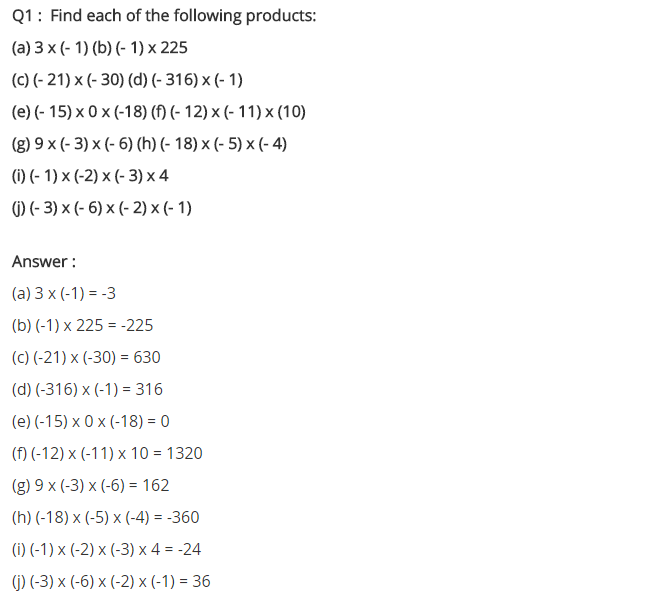

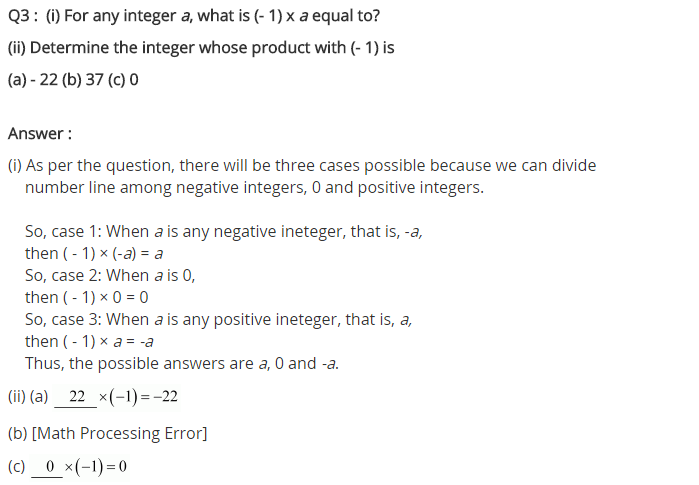
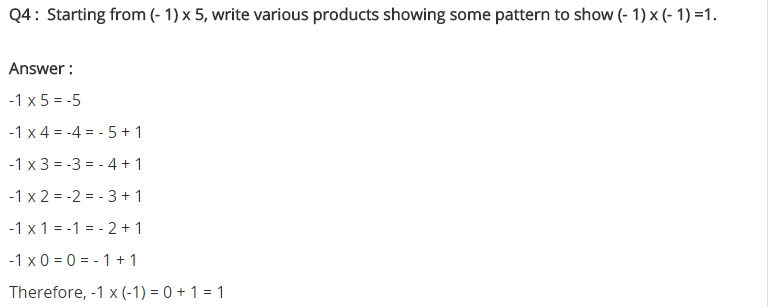
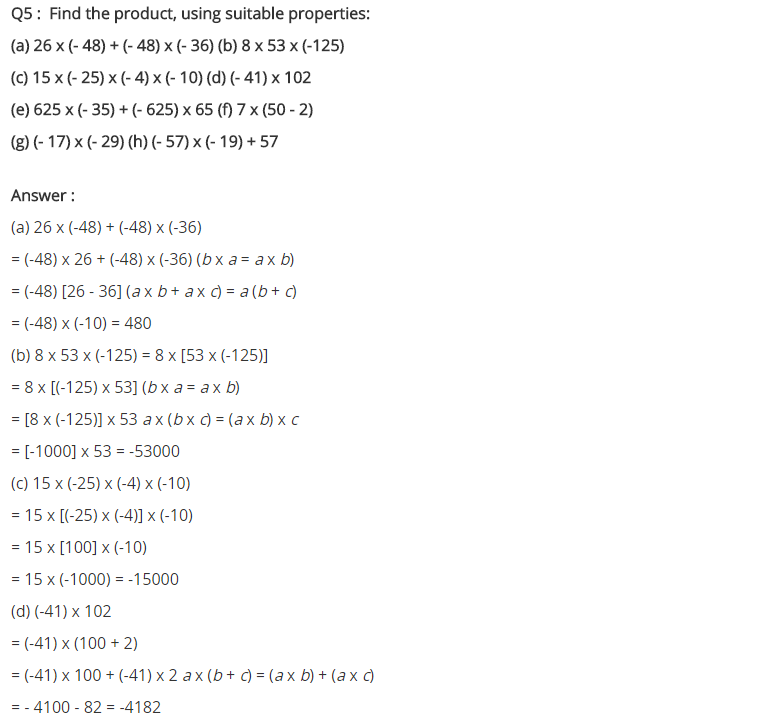
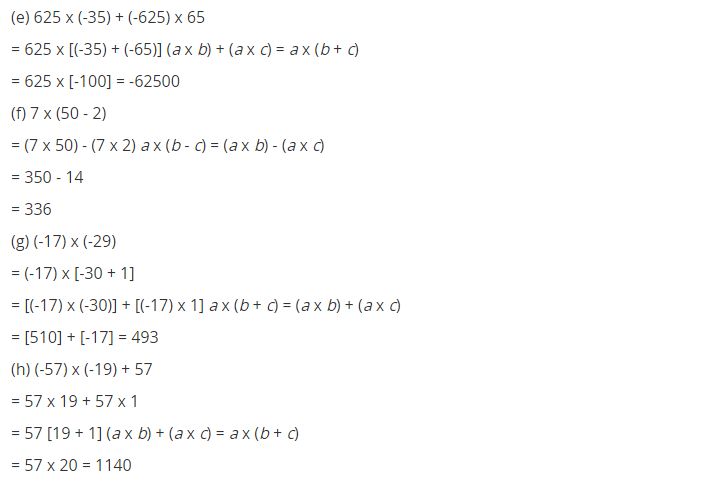

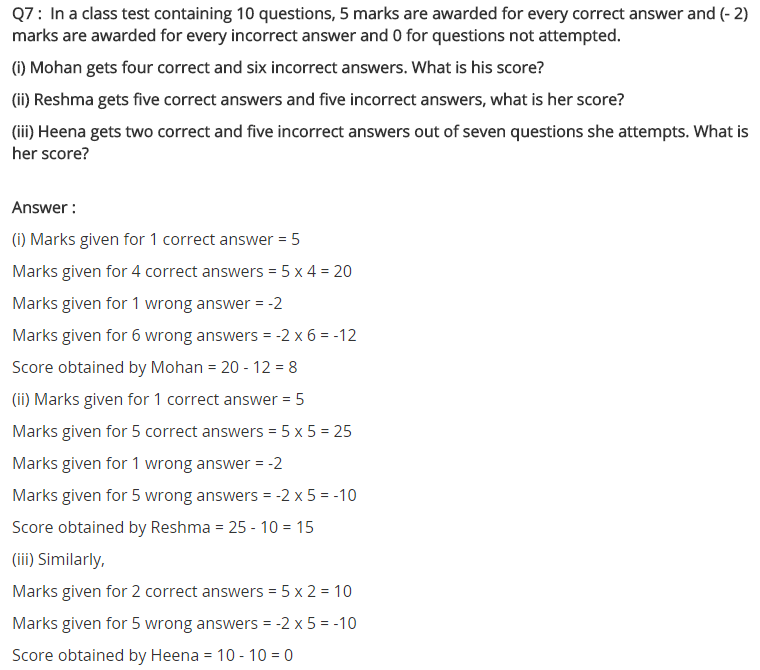
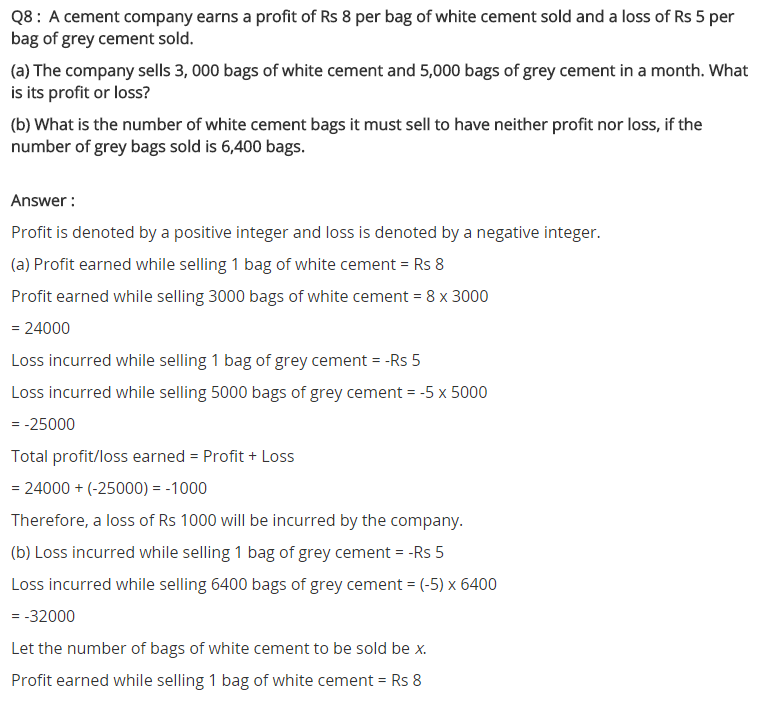
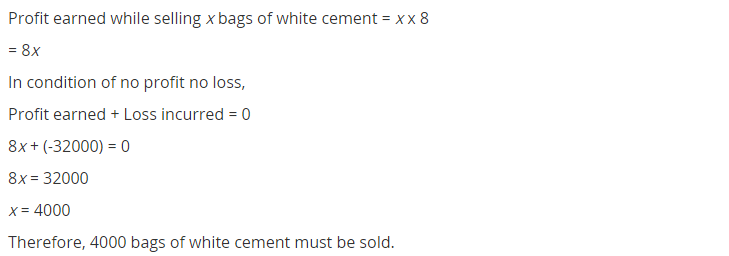
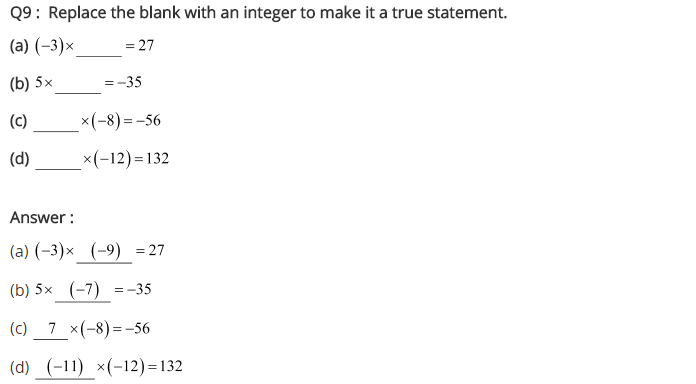
NCERT Solutions for Class 7 Maths Chapter 1 Integers Exercise 1.4
Ex 1.4 Class 7 Maths Question 1.
Evaluate each of the following:
(a) (-30) ÷ 10
(b) 50 ÷ (-5)
(c) (-36) ÷ (-9)
(d) (-49) ÷ (49)
(e) 13 ÷ [(-2) + 1]
(f) 0 ÷ (-12)
(g) (-31) ÷ [(-30) + (-1)]
(h) [(-36) ÷ 12] ÷ 3
(i) [(-6) + 5] ÷ [(-2) + 1]
Solution:
(a) (-30) ÷ 10 =
(b) 50 ÷ (-5) =
(c) (-36) ÷ (-9) =
(d) (-49) ÷ (49) =
(e) 13 ÷ [(-2) + 1] = 13 ÷ -1 =
(f) 0 ÷ (-12) =
(g) (-31) ÷ [(-30) + (-1)] = (-31) ÷ (-31) =
(h) [(-36) + 12] ÷ 3 =
=
(i) [(-6) + 5] + [(-2) + 1] = (-1) – (-1) =
Ex 1.4 Class 7 Maths Question 2.
Verify that: a ÷ (b + c) ≠ (a ÷ b) + (a ÷ c) for each of the following values of a, b and c.
(а) a = 12, b = – 4, c = 2
(b) a = (-10), b = 1, c = 1
Solution:
(a) a = 12, 6 = – 4, c = 2
a ÷ (b + c) = 12 ÷ [(-4) + 2]
= 12 ÷ (-2) =
(a ÷ b) + (a ÷ c) = [12 ÷ (-4)] + [12 ÷ 2]
Since, (-6) + 3
Hence, a ÷ (b + c) + (a ÷ b) + (a ÷ c)
(b) a = (-10), b = 1, c = 1
a ÷ (b + c) = (-10) ÷ (1 + 1)
=(-10) ÷ 2 =
(a ÷ b) + (a ÷ c)
=[(-10) ÷ 1] + [(-10) ÷ 1]
= (-10) + (-10) = -20
Since (-5) ≠ (-20)
Hence, a ÷ (b + c) ≠ (a ÷ b) + (a ÷ c)
Ex 1.4 Class 7 Maths Question 3.
Fill in the blanks:
(a) 369 ÷ ___ = 369
(b) (-75) ÷ ___ = -1
(c) (-206) ÷ ___ =1
(d) -87 ÷ ___ = -87
(e) ___ ÷ 1 = -87
(g) 20 ÷ ___ = -2
Solution:
(a) 369 ÷ ___ = 369 = 369 ÷ 1 = 369
(b) (-75) ÷ ___ = -1 = (-75) ÷ 75 = -1
(c) (-206) ÷ ___ = 1 = (-206) ÷ (-206) = 1
(d) 87 ÷ ___ = 87 = -87 ÷ (-1) = 87
(e) ___ ÷ 1 = -87 = -87 ÷ 1 = -87
(f) ___ ÷ 48 = -1 = (-48) ÷ 48 = -1
(g) 20 + ___ = -2 = 20 ÷ (-10) = -2
(h) ___ + (4) = -3 = (-12) ÷ (4) = -3
Ex 1.4 Class 7 Maths Question 4.
Write five pairs of integers (a, b) such that a ÷ b = -3. One such pair is (6, -2) because 6 + (-2) = -3.
Solution:
(a) (24, -8) because 24 ÷ (-8) = -3
(b) (-12, 4) because (-12) ÷ 4 = -3
(c) (15, -5) because 15 ÷ (-5) = -3
(d) (18, -6) because 18 ÷ (-6) = -3
(e) (60, -20) because 60 ÷ (-20) = -3
Ex 1.4 Class 7 Maths Question 5.
The temperature at 12 noon was 10°C above zero. If it decreases at the rate of 2°C per hour until midnight, at what time would the temperature be 8°C below zero? What would be the temperature at midnight?
Solution:
Temperature at 12 noon was 10°C above zero i.e. +10°C
Rate of decrease in temperature per hour = 2°C
Number of hours from 12 noon to midnight = 12
∴ Change in temperature in 12 hours
= 12 × (-2°C) = -24°C
∴ Temperature at midnight
= +10°C + (-24°C) = -14°C
Hence, the required temperature at midnight =-14°C
Difference in temperature between + 10°C and -8°C
= +10°C – (-8°C) = +10°C + 8°C = 18°C
Number of hours required =
∴ Time after 9 hours from 12 noon = 9 pm.
Ex 1.4 Class 7 Maths Question 6.
In a class test (+3) marks are given for every correct answer and (-2) marks are given for every incorrect answer and no marks for not attempting any question:
(i) Radhika scored 20 marks. If she has got 12 correct answers, how many questions has she attempted incorrectly?
(ii) Mohini scores -5 marks in this test, though she has got 7 correct answers. How many questions has she attempted incorrectly?
Solution:
Given that:
+3 marks are given for each correct answer. (-2) marks are given for each incorrect answer. Zero marks for not attempted questions.
(i) Marks obtained by Radhika for 12 correct answers = (+3) × 12 = 36
Marks obtained by Radhika for correct answers = 12 × 3 = 36
Total marks obtained by Radhika = 20
∴ Marks obtained by Radhika for incorrect answers = 20 – 36 = -16
Number of incorrect answers
Hence, the required number of incorrect answers = 8
(ii) Marks scored by Mohini = -5
Number of correct answers = 7
∴ Marks obtained by Mohini for 7 correct answers = 7 × (+3) – 21
Marks obtained for incorrect answers
= -5 – 21 = (-26)
∴ Number of incorrect answers
= (-26) ÷ (-2) = 13
Hence, the required number of incorrect answers – 13.
Ex 1.4 Class 7 Maths Question 7.
An elevator descends into a nine shaft at the rate of 6 m/min. If the descent starts from 10 m above the ground level, how long will it take to reach -350 m.
Solution:
The present position of the elevator is at 10 in above the ground level.
Distance moved by the elevator below the ground level = 350 m
∴ Total distance moved by the elevator = 350 m + 10 m = 360 m
Rate of descent = 6 m/min.
Total time taken by the elevator
= 60 minutes = 1 hour
Hence, the required time = 1 hour.
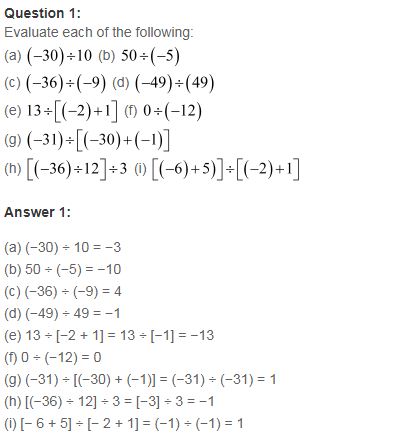
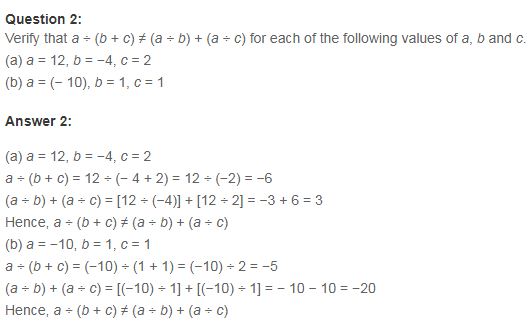
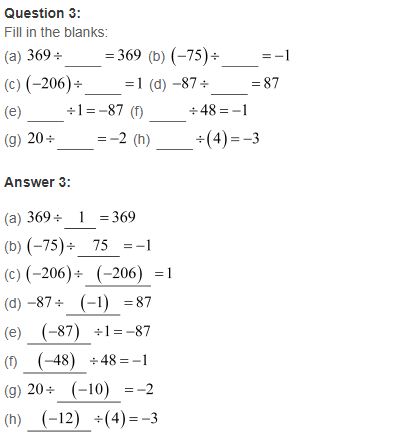
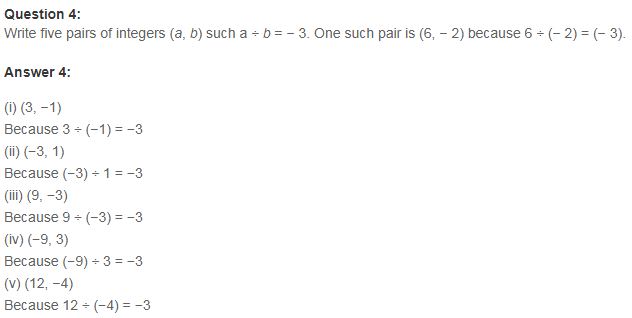
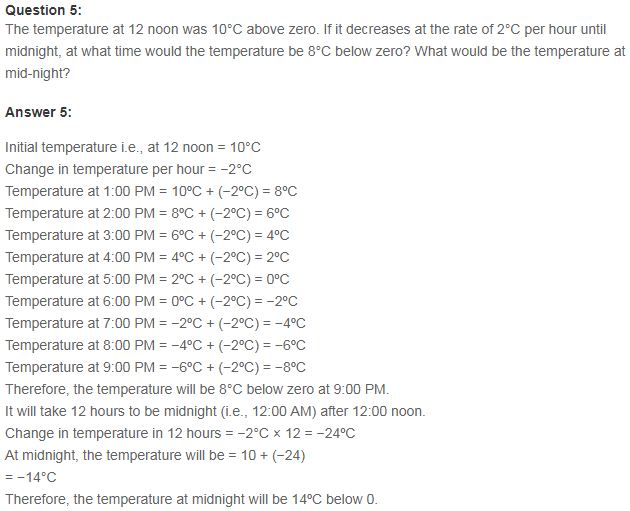
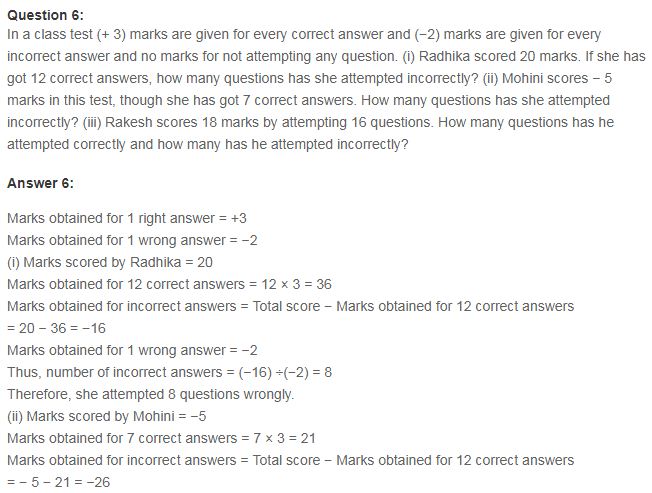
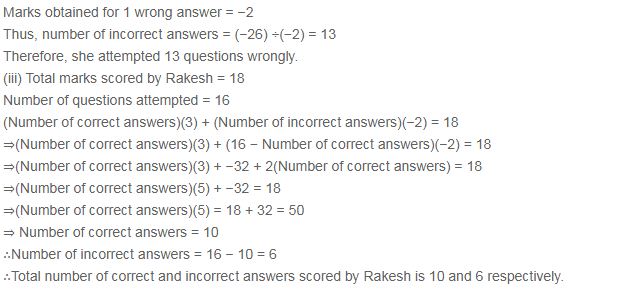
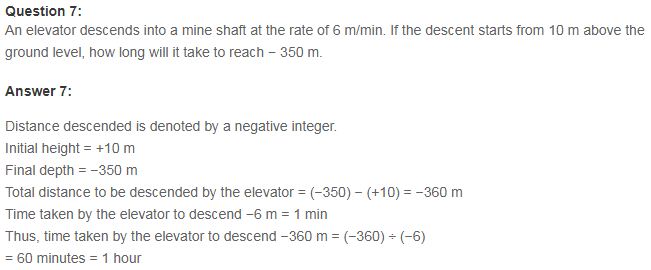
Integers Class 7 Extra Questions Maths Chapter 1
Extra Questions for Class 7 Maths Chapter 1 Integers
Integers Class 7 Extra Questions Very Short Answer Type
Question 1.
Fill in the blanks using < or >.
(a) -3 …… -4
(b) 6 ……. -20
(c) -8 …… -2
(d) 5 …… -7
Solution:
(a) -3 > -4
(b) 6 > -20
(c) -8 < -2
(d) 5 > -7
Question 2.
Solve the following:
(i) (-8) × (-5) + (-6)
(ii) [(-6) × (-3)] + (-4)
(iii) (-10) × [(-13) + (-10)]
(iv) (-5) × [(-6) + 5]
Solution:
(i) (-8) × (-5) + (-6)
= (-) × (-) × [8 × 5] + (-6)
= 40 – 6
= 34
(ii) [(-6) × (-3)] + (-4)
= (-) × (-) × [6 × 3] + (-4)
= 18 – 4
= 14
(iii) (-10) × [(-13) + (-10)]
= (-10) × (-23)
= (-) × (-) × [10 × 23]
= 230
(iv) (-5) × [(-6) + 5]
= (-5) × (-1)
= (-) × (-) × 5 × 1
= 5
Question 3.
Starting from (-7) × 4, find (-7) × (-3)
Solution:
(-7) × 4 = -28
(-7) × 3 = -21 = [-28 + 7]
(-7) × 2 – -14 = [-21 + 7]
(-7) × 1 = -7 = [-14 + 7]
(-7) × 0 = 0 = [-7 + 7]
(-7) × (-1) = 7 = [0 + 7]
(-7) × (-2) = 14 = [7 + 7]
(-7) × (-3) = 21 = [14 + 7]
Question 4.
Using number line, find:
(i) 3 × (-5)
(ii) 8 × (-2)
Solution:
(i) 3 × (-5)
From the number line, we have
(-5) + (-5) + (-5) = 3 × (-5) = -15
(ii) 8 × (-2)
From the number line, we have
(-2) + (-2) + (-2) + (-2) + (-2) + (-2) + (-2) + (-2) = 8 × (-2) = -16
Question 5.
Write five pair of integers (m, n ) such that m ÷ n = -3. One of such pair is (-6, 2).
Solution:
(i) (-3, 1) = (-3) ÷ 1 = -3
(ii) (9, -3) = 9 ÷ (-3) = -3
(iii) (6, -2) = 6 ÷ (-2) = -3
(iv) (-24, 8) = (-24) ÷ 8 = -3
(v) (18, -6) = 18 ÷ (-6) = -3
Integers Class 7 Extra Questions Short Answer Type
Question 6.
Solve the following:
(i) (-15) × 8 + (-15) × 4
(ii) [32 + 2 × 17 + (-6)] ÷ 15
Solution:
(i) (-15) × 8 + (-15) × 4
= (-15) × [8 + 4]
= (-15) × 12
= -180
(ii) [32 + 2 × 17 + (-6)] ÷ 15
= [32 + 34 – 6] ÷ 15
= [66 – 6] ÷ 15
= 60 ÷ 15
= 4
Question 7.
The sum of two integers is 116. If one of them is -79, find the other integers.
Solution:
Sum of two integers = 116
One integer = -79
Other integer = Sum of integer – One of integer = 116 – (-79) = 116 + 79 = 195
Question 8.
If a = -35, b = 10 cm and c = -5, verify that:
(i) a + (b + c) = (a + b) + c
(ii) a × (b + c) = a × b + a × c
Solution:
(i) Given that a = -35, b = 10, c = -5
LHS = a + (b + c) = (-35) + [10 + (-5)] = (-35) + 5 = -30
RHS = (a + b) + c = [(-35) + 10] + (-5) = (-25) + (-5) = -(25 + 5) = -30
LHS = RHS
Hence, verified.
(ii) a × (b + c) = a × b + a × c
LHS = a × (b + c) = (-35) × [10 + (-5)] = (-35) × 5 = -175
RHS = a × b + a × c = (-35) × 10 + (-35) × (-5) = -350 + (-) × (-) × (35 × 5) = -350 + 175 = -175
LHS = RHS
Hence, verified.
Question 9.
Write down a pair of integers whose
(i) sum is -5
(ii) difference is -7
(iii) difference is -1
(iv) sum is 0
Solution:
(i) (-2) + (-3) = -5
Hence, the required pair of integers = (-2, -3)
(ii) -10 – (-3) = -10 + 3 = -7
Hence, the required pair of integers = (-10, -3)
(iii) (-3) – (-2) = -1
Hence, the required pair of integers = (-3, -2)
(iv) (-4) + (4) = 0
Hence, the required pair of integers = (-4, 4)
Question 10.
You have ₹ 500 in your saving account at the beginning of the month. The record below shows all of your transactions during the month. How much money is in your account after these transactions?
Solution:
Amount in the beginning of the month in the account = ₹ 500
Amount deposited in the account for Jal Board = ₹ 200
Amount paid to Jal Board = ₹ 120
Amount left in the account after the above transactions = ₹ (500 + 200 – 120) = ₹ (700 – 120) = ₹ 580
Amount deposited for LIC India = ₹ 150
Amount paid to LIC India = ₹ 240
Amount left after this transactions = ₹ (580 + 150 – 240) = ₹ (730 – 240) = ₹ 490
Question 11.
The given table shows the freezing points in °F of different gases at sea level. Convert each of these into °C to the nearest integral value using the relations and complete the table
C = 
Solution:
Freezing point of Hydrogen = -435°F
C =
=
= 5 × (-51.9)
= 259.5°C or 259°C
For Krypton, freezing point = -251°F
C =
=
= 5 × (-31.4)]
= -157°C
For Oxygen, freezing point = -369°F
C =
=
= 5 × (44.56)
= 222.80° C or 223°C
Hence, the required freezing points at sea level in °C for Hydrogen = -259°C, Krypton = -157°C, Oxygen = -223°C.
Question 12.
Taking today as zero on the number line, if the day before yesterday is 17 January, what is the date on 3 days after tomorrow? [NCERT Exemplar]
Solution:
The date before yesterday = 17 January
The date of yesterday = 17 + 1 = 18 January
Today’s date = 18 + 1 = 19 January
Tomorrow’s date = 19 + 1 = 20 January
Date on 3 days after tomorrow = (20 + 3) = 23rd January
.png)
.png)